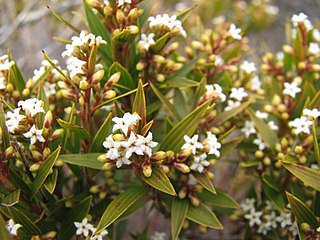
Leucopogon neurophyllus, commonly known as veined beard-heath, is a species of flowering plant in the heath family Ericaceae and is endemic to Victoria in Australia. It is a dense shrub with many branches, erect, narrowly elliptic leaves, and white, tube-shaped flowers that are densely bearded inside.

Leucopogon juniperinus, commonly known as prickly beard-heath, is a species of flowering plant in the heath family Ericaceae and is endemic to south-eastern continental Australia. It is an erect, densely-branched shrub with oblong to more or less egg-shaped leaves with the narrower end towards the base, and white, tube-shaped flowers arranged singly in upper leaf axils.

Leucopogon ericoides, commonly known as the pink beard-heath, is a species of flowering plant in the heath family Ericaceae and is endemic to south-eastern Australia. It is a slender shrub with oblong leaves, and white to pinkish, tube-shaped flowers.

Leucopogon amplexicaulis, commonly known as beard-heath, is a species of flowering plant in the heath family Ericaceae and is endemic to eastern New South Wales. It is a scrambling or straggly shrub with egg-shaped, stem-clasping leaves with hairy edges, and spikes of small white flowers.
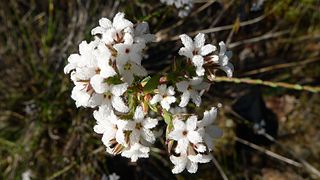
Leucopogon microphyllus is a species of flowering plant in the heath family Ericaceae and is endemic to eastern Australia. It is a bushy or spreading shrub with egg-shaped leaves, sometimes with the narrower end towards the base, and compact spikes of usually four to nine white, tube-shaped flowers.

Leucopogon affinis, commonly known as lance beard-heath and formerly known as Leucopogon lanceolatus is a flowering plant in the heath family Ericaceae and is endemic to eastern Australia, including Tasmania and South Australia. It is an erect shrub with spikes of small white flowers in early spring, followed by orange-red fruit.
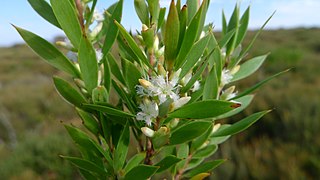
Leucopogon esquamatus, commonly known as the swamp beard-heath, is a species of flowering plant in the heath family Ericaceae and is endemic to south-eastern Australia. It is a slender shrub with mainly elliptic leaves, and short-lived white, tube-shaped flowers arranged singly or in pairs in upper leaf axils.
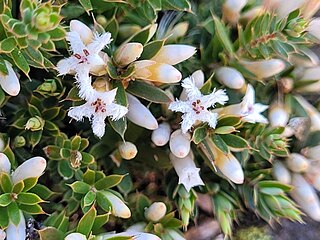
Leucopogon fraseri is a species of flowering plant in the heath family Ericaceae and is native to south-eastern continental Australia and New Zealand, where it is known as Styphelia nesophila, pātōtara, or dwarf mingimingi. It is a prickly, prostrate to trailing or low-growing shrub with egg-shaped leaves, and erect, tube-shaped white flowers usually arranged singly in leaf axils.

Leucopogon australis, commonly known as spiked beard-heath, is a species of flowering plant in the heath family Ericaceae and is endemic to southern Australia. It is an erect, aromatic shrub with narrowly egg-shaped to narrowly elliptic leaves, and white flowers arranged in spikes near the ends of branchlets.

Leucopogon collinus, commonly known as fringed beard-heath, is a species of flowering plant in the heath family Ericaceae and is endemic to south-eastern Australia. It is a slender, erect or spreading shrub with narrowly lance-shaped leaves, and white, tube-shaped, bearded flowers.

Leucopogon gilbertii is a species of flowering plant in the heath family Ericaceae and is endemic to the south-west of Western Australia. It is a slender shrub with linear to lance-shaped leaves and spikes of tube-shaped white flowers on the ends of branches and in leaf axils.

Leucopogon glacialis, the twisted beard-heath, is a species of flowering plant in the family Ericaceae and is endemic to south-eastern continental Australia. It is a spreading to erect shrub with narrowly egg-shaped to lance-shaped leaves, and crowded spikes of white flowers.

Leucopogon melaleucoides is a species of flowering plant in the heath family Ericaceae and is endemic to eastern Australia. It is an erect, densely branched shrub with lance-shaped or egg-shaped leaves, and white, tube-shaped flowers arranged in spikes in upper leaf axils.

Leucopogon pilifer, commonly known as thready beard-heath, is a species of flowering plant in the heath family Ericaceae and is endemic to south-eastern Australia. It is a low-lying, dwarf, often mat-forming shrub with long branches, oblong to lance-shaped leaves and crowded, white spikes of densely bearded flowers arranged in groups of between 4 and 9.

Leucopogon riparius is a species of flowering plant in the heath family Ericaceae and is endemic to eastern Victoria in Australia. It is an erect shrub with narrowly elliptic to narrowly egg-shaped leaves, the narrower end towards the base, and white, tube-shaped flowers arranged in groups of 3 to 5 in leaf axils.

Leucopogon rodwayi is a species of flowering plant in the heath family Ericaceae and is endemic to coastal New South Wales. It is an erect to spreading shrub with narrowly egg-shaped to elliptic leaves, and pendent, white, tube-shaped flowers arranged in groups of 6 to 15 in leaf axils, forming a spike up to 8 mm (0.31 in) long.
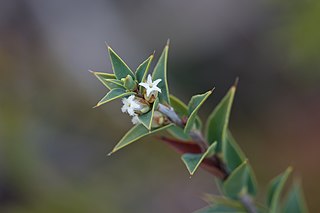
Leucopogon rufus, commonly known as spoon-leaf beard-heath or ruddy bearded-heath, is a species of flowering plant in the heath family Ericaceae and is endemic to south-eastern continental Australia. It is an erect shrub with erect to spreading, egg-shaped leaves and white, tube-shaped flowers arranged in spikes in two to five leaf axils near the ends of branches.

Leucopogon thymifolius, commonly known as thyme beard-heath, is a species of flowering plant in the heath family Ericaceae and is endemic to Victoria. It is a slender shrub with spreading, egg-shaped to oblong leaves and white to pale pink, tube-shaped flowers arranged in spikes of seven to thirteen in leaf axils, or on the ends of leafless branches.

Leucopogon virgatus, commonly known as common beard-heath, is a species of flowering plant in the heath family Ericaceae and is endemic to south-eastern Australia. It is an erect to low-lying shrub with linear to narrowly lance-shaped or egg-shaped leaves, and erect clusters of three to seven white, tube-shaped flowers on the ends of branches and in upper leaf axils.
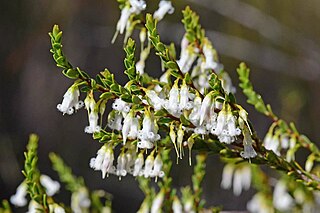
Leucopogon woodsii, commonly known as nodding beard-heath, is a species of flowering plant in the heath family Ericaceae and is endemic to southern continental Australia. It is a slender shrub with more or less erect, egg-shaped leaves, and pendent white, tube-shaped flowers with densely bearded lobes.





















